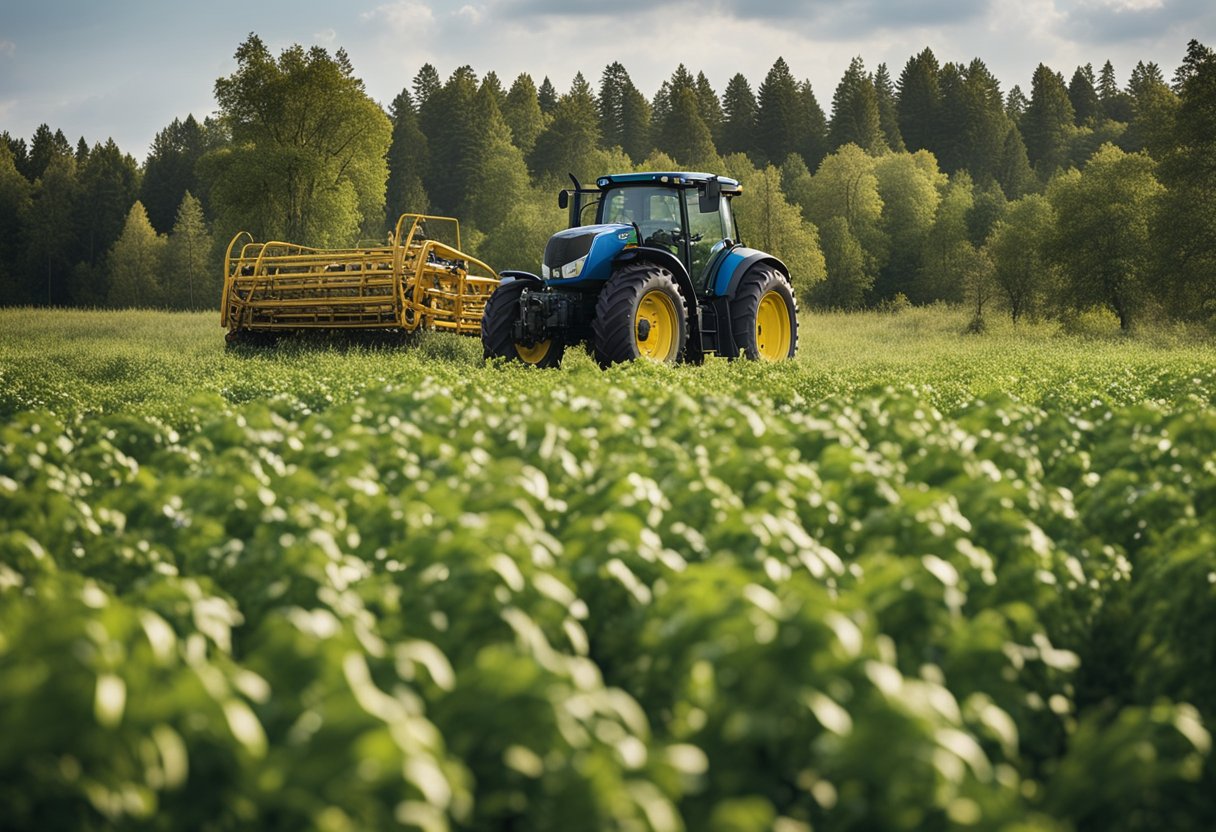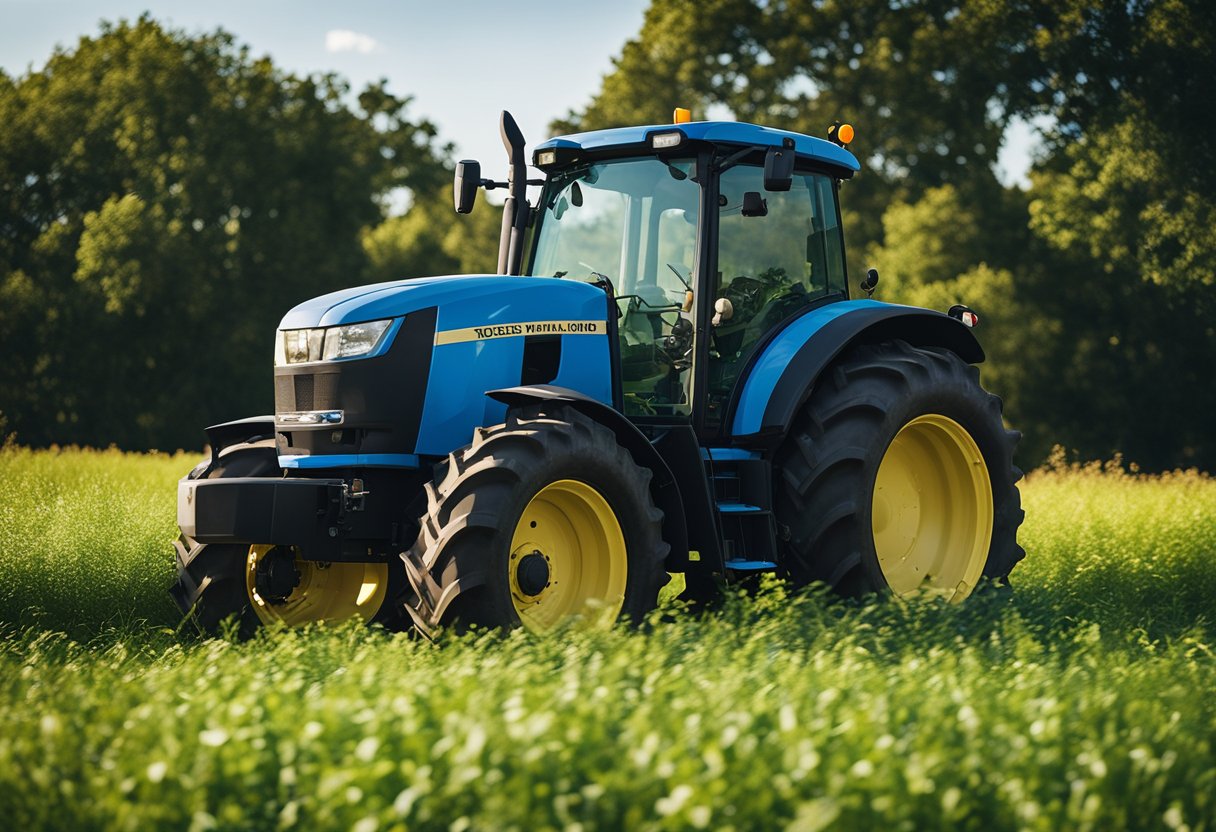As a bush hogging business owner, one of the most critical aspects of your business is how much you charge for your services. Setting the right price can make a significant difference in your bottom line, and it can be challenging to determine the right rate. There are several factors to consider when setting your prices, such as the size of the land, the type of terrain, and the equipment used.
Understanding bush hogging is essential before setting your prices. Bush hogging is the process of cutting down and clearing overgrown vegetation, including small trees, shrubs, and tall grasses. It is a necessary process for landowners who want to maintain their property or prepare it for future use. Bush hogging can be a time-consuming and challenging task, which is why many landowners hire professionals to handle it for them.
Key Takeaways
- Understanding the process of bush hogging is essential before setting your prices.
- Several factors influence the cost of bush hogging, such as the size of the land, the type of terrain, and the equipment used.
- Estimating the cost of bush hogging accurately is critical to ensure that you set the right price and make a profit.
Understanding Bush Hogging
https://www.youtube.com/watch?v=WEhMNMCGxac&embed=true
As someone who has been in the bush hogging business for years, I know that it can be a challenge to figure out how much to charge for this service. But before we get into pricing, let’s first understand what bush hogging is.
Bush hogging, also known as brush hogging or rotary cutting, is a method of clearing vegetation, overgrowth, bushes, shrubs, and saplings from an area of land. It is typically done using a specialized piece of equipment called a bush hog or brush hog, which is a type of rotary cutter that is attached to a tractor or other heavy equipment.
The purpose of bush hogging is to clear land for various purposes, including agricultural uses, land development, and landscaping. It is often used to clear fields and pastures, as well as to remove overgrown vegetation from woodlots and other areas.
When it comes to pricing for bush hogging services, there are several factors to consider. These include the size of the area to be cleared, the type of vegetation that needs to be removed, and the terrain of the land. Other factors that can affect pricing include the cost of transportation, equipment rental fees, and labor costs.
Overall, the cost of bush hogging can vary widely depending on these factors and others. However, with a clear understanding of what bush hogging is and what factors can affect pricing, you can make informed decisions about how much to charge for your services.
Essential Equipment for Bush Hogging
When it comes to bush hogging, having the right equipment is essential for getting the job done efficiently and effectively. Here are some of the key pieces of equipment that I recommend having on hand:
Tractor
A tractor is the most important piece of equipment for bush hogging. It provides the power and stability needed to operate the bush hog, which is a heavy-duty rotary mower. When choosing a tractor, it’s important to consider factors such as horsepower, weight, and size to ensure that it can handle the size of the job you’re working on.
Bush Hog
The bush hog is the actual cutting device that attaches to the tractor. It’s important to choose a bush hog that is the right size for your tractor and the job at hand. There are several types of bush hogs available, including standard, heavy-duty, and batwing models.
Blades
The blades on your bush hog are crucial for getting a clean cut. It’s important to keep them sharp and in good condition to ensure that they are cutting efficiently. You may need to replace your blades periodically, depending on how often you use your bush hog.
Truck and Trailer
Having a truck and trailer is important for transporting your equipment to and from job sites. It’s important to choose a truck and trailer that are capable of handling the weight of your equipment and that are easy to maneuver on the road.
Equipment Trailer
An equipment trailer is another option for transporting your bush hog and other equipment. It’s important to choose a trailer that is the right size for your equipment and that is easy to load and unload.
Tools
Having the right tools on hand can make a big difference when it comes to maintaining your equipment and making repairs. Some of the tools that I recommend having on hand include wrenches, sockets, pliers, and screwdrivers.
Overall, having the right equipment is essential for successful bush hogging. By investing in quality equipment and keeping it well-maintained, you can ensure that you’re able to tackle any job that comes your way.
Factors Influencing Bush Hogging Costs
https://www.youtube.com/watch?v=wN4uD6zWWCs&embed=true
When it comes to bush hogging, the cost of the job depends on several factors. As someone who has been in the bush hogging business for a while, I can tell you that the following factors have a significant impact on how much you should charge for the service.
Terrain
The terrain of the land is one of the main factors that affect the cost of bush hogging. If the land is flat and easy to navigate, the job will be faster and less expensive. However, if the terrain is rocky, hilly, or uneven, the job will take longer, and you may need specialized equipment to get the job done. In such cases, you may want to consider charging extra for the additional time and equipment required.
Density of Vegetation
The density of the vegetation also has a significant impact on the cost of bush hogging. If the land has tall grass, thick weeds, or overhanging limbs, the job will take longer and require more effort. In such cases, it is essential to charge more for the extra time and effort needed to complete the job.
Area and Acreage
The size of the land and the acreage is another critical factor that affects the cost of bush hogging. The larger the area, the more time it will take to complete the job. As a result, you may want to charge more for larger jobs. Additionally, if the land has obstacles such as stumps or rocks, it will take longer to complete the job, and you may need to charge extra for the additional time and effort required.
Distance
The distance of the job site from your location is another factor that can affect the cost of bush hogging. If the job site is far away, you may need to charge extra for travel expenses, such as gas and time spent driving to the site.
Equipment
The type of equipment required to complete the job is also a factor that affects the cost of bush hogging. If the job requires specialized equipment, such as a tractor or a brush cutter, you may need to charge extra for the use of the equipment.
In conclusion, the cost of bush hogging depends on several factors, including terrain, density of vegetation, area and acreage, distance, and equipment. As a bush hogging professional, it is essential to consider all of these factors when determining how much to charge for the job.
Estimating the Cost of Bush Hogging
https://www.youtube.com/watch?v=hDsUlCdzs7A&embed=true
As a professional bush hogger, I know that estimating the cost of bush hogging can be a bit tricky. The cost of bush hogging depends on various factors such as the size of the land, terrain, difficulty, and the amount of work required. Therefore, it is essential to understand how these factors affect the cost of bush hogging before charging your clients.
When estimating the cost of bush hogging, it is crucial to consider the hourly rate or the going rate in the market. According to my research, the average hourly rate for bush hogging ranges between $80 to $250 per hour. However, the cost can vary depending on the location and the competition in the market.
Another crucial factor to consider when estimating the cost of bush hogging is the size of the land. Typically, the cost of bush hogging is calculated based on the square footage of the land. According to the chart I found, the cost of bush hogging an acre of land can range between $350 to $8,000.
However, it is essential to note that the cost of bush hogging can vary based on the terrain and difficulty of the land. For instance, if the land has long saplings or is difficult to access, it may take more time and effort to complete the job, which can increase the cost of bush hogging. Therefore, it is essential to assess the land before providing an estimate to your clients.
In conclusion, estimating the cost of bush hogging requires consideration of various factors such as the hourly rate, size of the land, terrain, and difficulty. By understanding these variables, you can provide your clients with an accurate estimate and avoid overcharging or undercharging them.
The Business Side of Bush Hogging
https://www.youtube.com/watch?v=IXuk91afRyo&embed=true
As a bush hogging professional, I understand that charging the right amount for your services is crucial to the success of your business. The amount you charge should be competitive and fair, while also taking into account your expenses, time, and effort.
When setting your prices, it’s important to consider the local market and your target customer base. You should also take into account the type of job you will be doing, as some jobs may require more equipment, time, and effort than others.
Another important factor to consider is your expenses. This includes the cost of equipment, fuel, and any other expenses related to your business. It’s important to factor in these costs when setting your prices to ensure that you are making a profit.
To make your services more appealing to customers, you may also consider offering discounts for repeat business or for referrals. This can help you build a loyal customer base and attract new customers.
Investing in professional content and marketing can also help you stand out from the competition and attract more customers. This can include creating a website, social media profiles, and other marketing materials that showcase your services and expertise.
Overall, the hourly rate for bush hogging can range from $20 to $250, depending on various factors such as the job type, terrain, and equipment needed. It’s important to do your research and consider all of these factors when setting your prices. As a responsible and knowledgeable business owner, I strive to provide my customers with quality service at a fair price.
Maintenance and Repairs
https://www.youtube.com/watch?v=lUE-mXEjYyA&embed=true
As a professional bush hogging operator, I understand the importance of maintaining and repairing my equipment. Regular maintenance ensures that my machinery is in good working condition, which minimizes downtime and maximizes productivity. It also helps to extend the life of my equipment.
To keep my equipment in good condition, I regularly inspect my machinery, tools, and blades. I also keep my blades sharp to ensure that they cut through thick vegetation with ease. This not only improves the quality of my work but also reduces the wear on my equipment.
In addition to regular maintenance, I also perform heavy maintenance and repairs as needed. This includes replacing worn-out parts, repairing damaged components, and performing major overhauls. I understand that these repairs can be costly, but they are necessary to keep my equipment running smoothly and safely.
To protect myself and my clients, I carry insurance that covers any damages or injuries that may occur during the bush hogging process. This gives me peace of mind knowing that I am protected in case of an accident or unexpected event.
In summary, maintaining and repairing my equipment is crucial to my success as a bush hogging operator. It ensures that my equipment is in good working condition, reduces downtime, and improves the quality of my work. It also protects me and my clients from any unexpected events that may occur during the bush hogging process.
Additional Considerations for Bush Hogging
When it comes to bush hogging, there are a few additional considerations that are important to keep in mind. Whether you are clearing land for landscaping or agricultural use, or simply maintaining a dirt road, it’s important to take these factors into account when determining how much to charge for your services.
One important consideration is the type of vegetation that you will be cutting. If you are dealing with dry grass or neglected brush, for example, it may take longer to complete the job than if you are simply cutting down a few small trees. Additionally, if you are cutting down trees or plants that have thorns or other sharp features, it may be necessary to take extra precautions to protect your equipment and ensure the safety of yourself and your crew.
Another factor to consider is the size and scope of the job. If you are clearing a large pasture or agricultural field, for example, it may take several days to complete the job. On the other hand, if you are simply cutting a small patch of grass or clearing a dirt road, the job may only take a few hours. It’s important to factor in the time and labor required for each job when determining your pricing.
Finally, it’s important to consider any additional services that may be required. For example, if you are towing equipment to the job site, you may need to factor in the cost of fuel and maintenance. Additionally, if you are working on a development or construction site, you may need to obtain permits or meet other regulatory requirements. By taking all of these factors into account, you can ensure that you are providing your clients with accurate and fair pricing for your bush hogging services.
Frequently Asked Questions
What is the average cost of bush hogging per acre?
The average cost of bush hogging per acre varies depending on several factors such as the size of the land, the thickness of the vegetation, and the terrain. According to Mighty Pricey, the average cost of bush hogging per acre is about $350 to $8000. However, the cost may be higher or lower depending on the factors mentioned above.
How much should I charge for bush hogging services?
The amount you should charge for bush hogging services depends on the factors mentioned above. If the land is small and the vegetation is not too thick, you can charge a lower rate. However, if the land is large and the vegetation is thick, you may need to charge a higher rate. According to TractorByNet, some operators charge a first-hour fee of $200 and $100 per hour after that.
What factors affect the cost of bush hogging?
Several factors affect the cost of bush hogging. The size of the land, the thickness of the vegetation, and the terrain are some of the factors that affect the cost of bush hogging. Other factors include the type of equipment used, the experience level of the operator, and the amount of time it takes to complete the job.
How long does it take to bush hog an acre of land?
The amount of time it takes to bush hog an acre of land varies depending on the factors mentioned above. According to Mighty Pricey, clearing one acre of land takes about 3-4 hours on average. However, the time it takes may be longer or shorter depending on the size of the land, the thickness of the vegetation, and the terrain.
Is bush hogging a profitable business?
Bush hogging can be a profitable business if you have the right equipment and experience. According to Inside The Yard, the profit margin for bush hogging can be between 40% to 60%. However, the profit margin may be lower or higher depending on the factors mentioned above.
What is the largest size brush that a bush hog can cut?
The largest size brush that a bush hog can cut depends on the type of equipment used. However, most bush hogs can cut brush up to 1 inch in diameter. If you need to cut larger brush, you may need to use a different type of equipment or hire a professional with the right equipment.

Hi, I’m Sal Muller of Tooltrip.com. My DIY experience led me to understand essential power tools for home projects. Tooltrip.com guides enthusiasts and professionals in choosing right tools for any job. I provide concise top tool reviews for easier, efficient DIY.





